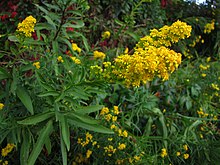| Solidago sempervirens | |
|---|---|

| |
| Woods Hole, Massachusetts | |
| Scientific classification | |
| Kingdom: | Plantae |
| Clade: | Tracheophytes |
| Clade: | Angiosperms |
| Clade: | Eudicots |
| Clade: | Asterids |
| Order: | Asterales |
| Family: | Asteraceae |
| Genus: | Solidago |
| Species: | S. sempervirens
|
| Binomial name | |
| Solidago sempervirens | |

| |
| Distribution in United States + Canada[1] | |
| Synonyms[2] | |
| |
Wikimedia Commons has media related to Solidago sempervirens.
Solidago sempervirens, the seaside goldenrod[3] or salt-marsh goldenrod,[4] is a plant species in the genus Solidago of the family Asteraceae. It is native to eastern North America and parts of the Caribbean. It is an introduced species in the Great Lakes region.[5] Similar plants found in the Azores (now Solidago azorica) are thought have evolved from a natural introduction of this species.[6][7]
- ^ United States Department of Agriculture Plants Profile: Solidago sempervirens
- ^ The Plant List, Solidago sempervirens
- ^ USDA, NRCS (n.d.). "Solidago sempervirens". The PLANTS Database (plants.usda.gov). Greensboro, North Carolina: National Plant Data Team. Retrieved 19 November 2015.
- ^ BSBI List 2007 (xls). Botanical Society of Britain and Ireland. Archived from the original (xls) on 2015-06-26. Retrieved 2014-10-17.
- ^ Biota of North America Program 2014 county distribution map
- ^ Erik Sjögren Plants and Flowers in the Azores, 2001
- ^ Schaefer, Hanno (2015-05-29). "On the origin and systematic position of the Azorean goldenrod, Solidago azorica (Asteraceae)". Phytotaxa. 210 (1): 47. doi:10.11646/phytotaxa.210.1.5. Retrieved 24 June 2021.